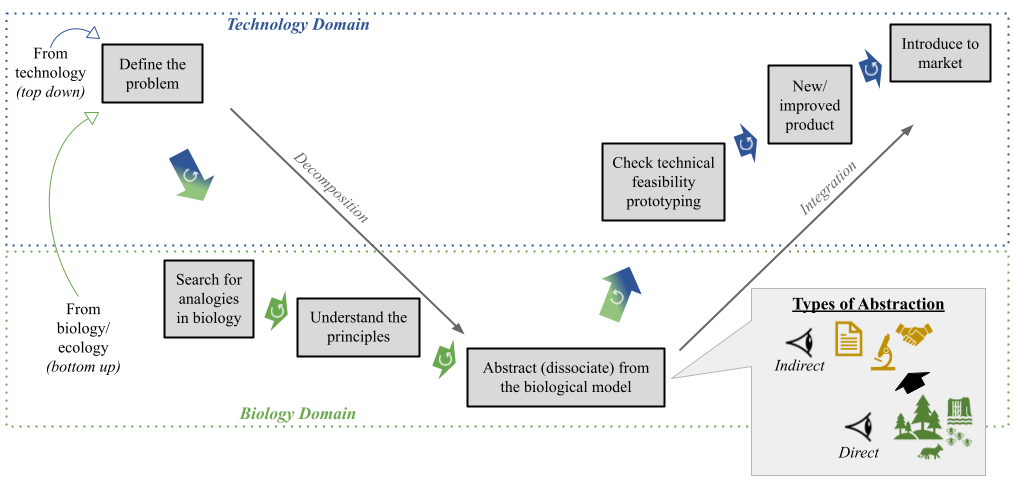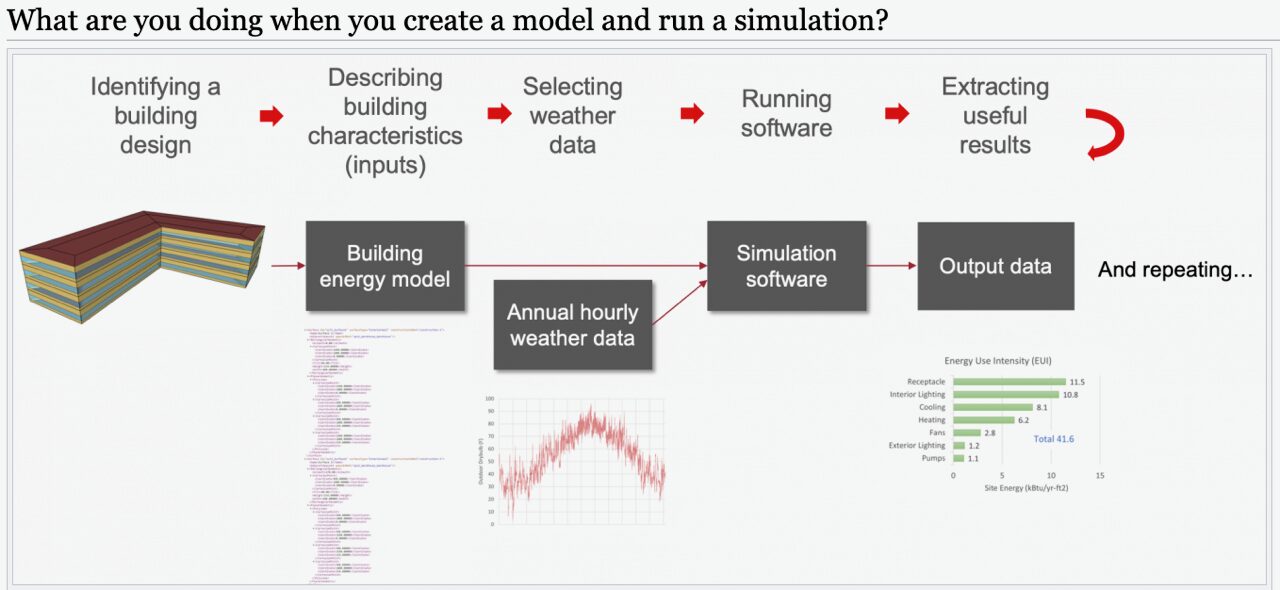I’m interested in biomimetic design–how can I incorporate biomimicry into a building system model?
- Biophile
Dear Biophile,
To answer this question, the first important step is to understand what biomimicry is and to distinguish between biomimetic and non-biomimetic design practices. Most simply, biomimetics – from bio meaning “relating to life” and mimesis meaning “to imitate” – is the practice of learning from and emulating nature for technological innovation. To a large extent, this is not a new concept. Since the 1950s, model-based biomimicry has been used to design and construct vehicles, including water, air, and land transit. Today, biomimetics is an established scientific practice governed by the international standard ISO 18458,1 and it is growing in its application domains, from nanoscale to large regional systems. Building systems are included in this, which I’ll discuss more shortly.
In terms of the methodology, a product, process, or system is biomimetic if three criteria are met: (1) functional analysis of the biological system, (2) abstraction from system to model, and (3) transfer and application without using the biological system. By these criteria, a green roof uses nature, so this would not be considered biomimetic (instead, this falls under nature-based solutions). On the other hand, adaptive building facades that reduce solar heat gain by mimicking the structure and movement of leaves are biomimetic.2 Further, a typical biomimetic design process follows seven iterative steps, from defining the problem to introduction to the market, as shown in the schematic below. Through this process, teams decompose the high-level idea into its parts before integrating the detailed design features back into the whole for end use. For biomimicry, this process moves between technology and biology domains, with the design opportunity either originating from technology (i.e., “top down”, most common as engineers) or biology (i.e., “bottom up”). At the same time, this general framework has synergies with typical model-based systems engineering practices that are familiar for building system modelers (such as the V-model). Within this overall framework, the biomimetic building system model is created, validated, and improved in the abstraction and feasibility stages.

A methodological schematic representing the typical seven-stage, iterative biomimetic design process based on ISO 18458 with variants for opportunity recognition (top down, bottom up) and abstraction (direct, indirect).
The translation between biological and technological domains always involves a model, which can range from concept models and static mathematical functions to dynamic multi-variate systems of equations. To incorporate biomimicry into building modeling and simulation, there are many software tools available. Multi-domain modeling languages offer the greatest flexibility, which includes MATLAB/Simulink, Modelica, Python, and Julia, among others. For example, MATLAB has been used for a termite-inspired fault detection algorithm for high-rise concrete structures.3 In addition, buildings-specific modeling environments can be used. For example, EnergyPlus was used to design and evaluate novel envelope and cooling technologies inspired from animal and plant heat transfer mechanisms.4 In the energy model, this study adjusted the wall U-values, cooling equipment performance values, and the window reflectance, among others, to represent the biomimetic features, which together reduced annual energy consumption by ~60%.4 Further, co-simulation platforms (such as FMI, Ladybug Tools, or Grasshopper for Rhino 3D) that integrate typically disparate modeling environments are well-suited for biomimetic modeling and have yet to be thoroughly explored.
There are numerous other examples of biomimicry for buildings. Among building applications, biomimicry can be used for materials/structures,5 energy systems,4 and control systems (i.e., structural monitoring,3 multi-zone temperature control,6 and bio-inspired optimization algorithms for building energy).7 Among complete buildings, the Eastgate Center in Harare, Zimbabwe (pictured below) is one of the most well-known examples. This shopping center has a passive cooling design that was inspired by termite mounds, leveraging high thermal mass, large open spaces, and various openings throughout the building to enable natural ventilation and passive cooling.

The Eastgate Center in Harare, Zimbabwe is one of the most famous examples of biomimetic design for buildings. The shopping center learned how termite mounds (left) modulate temperature to create natural ventilation strategies for high-rise buildings (center). These strategies were implemented in the Eastgate Center (right).
While biomimicry in building modeling is largely a nascent practice, there are several resources and best practices available to aid success and innovation. For example, AskNature.org from The Biomimicry Institute has collections of biological strategies and innovations, many of which are suitable for building applications. Just as with best practices for building modeling, an important first step is to understand the physical principles, from both biological and technical perspectives. The modeling and simulation tool(s) are then selected based on the principle requirements. When checking technical feasibility, care and attention should also be paid to the evaluation metrics, which can include both traditional and novel key performance indicators. Lastly, it is important to not misinterpret biophilic biases for educated engineering decisions. Nature can be a source of inspiration for what sustainable buildings look, act, and feel like. Scientifically guided practices such as ISO 18458 can help deliver biomimetic solutions for buildings that move beyond innovation for innovation’s sake, and into development for human and ecosystem wellbeing and sustainability.

Postdoctoral Scholar, Pennsylvania State University
Dr. Kathryn Hinkelman has a B.S. in Mechanical Engineering (University of Denver), an M.S. in Mechanical Engineering (University of California at Berkeley), and a Ph.D. in Architectural Engineering (Pennsylvania State University). She is a recipient of the U.S. Department of Energy IBUILD Fellowship, the international P.E.O. Scholar Award, and Phi Beta Kappa. Before her doctoral studies, Kathryn worked at the Boulder Engineering Company, where she designed electrical and mechanical systems for multi-family residential and commercial buildings across the United States. Her research focuses on modeling and simulation of building and district energy systems and controls, to improve active systems deployed today and design innovative biomimetic solutions for future sustainable and resilient communities. She is an expert in Modelica, and over a dozen of her models have been publicly released in LBNL’s Modelica Buildings Library and the IBPSA Modelica Library.
References
- ISO/TC 266. Biomimetics – Terminology, concepts and methodology. ISO 184582015(E) (2015).
- Sheikh, W. T. & Asghar, Q. Adaptive biomimetic facades: Enhancing energy efficiency of highly glazed buildings. Front. Archit. Res. 8, 319–331 (2019).
- Minh, H. Le et al. Damage identification in high-rise concrete structures using a bio-inspired meta-heuristic optimization algorithm. Adv. Eng. Softw. 176, 103399 (2023).
- Fu, S. C. et al. Bio-inspired cooling technologies and the applications in buildings. Energy Build. 225, (2020).
- Stachew, E., et al. Root Systems Research for Bioinspired Resilient Design: A Concept Framework for Foundation and Coastal Engineering. Front. Robot. AI 8, 548444 (2021).
- Pantoja, A., et al. A bioinspired approach for a multizone temperature control system. Bioinspiration and Biomimetics 6, 13 (2011).
- Bamdad, K., et al. Ant colony algorithm for building energy optimisation problems and comparison with benchmark algorithms. Energy Build. 154, 404–414 (2017).





